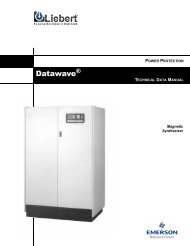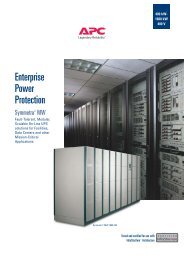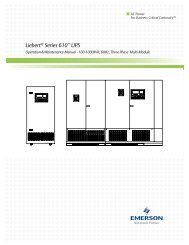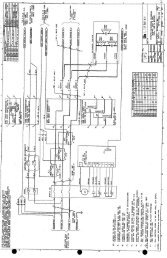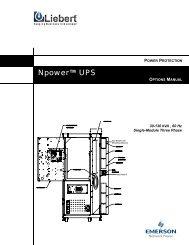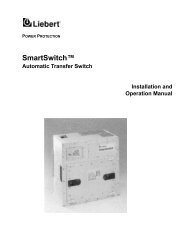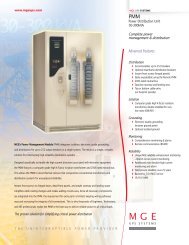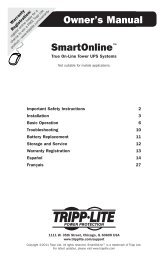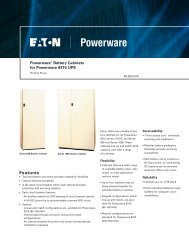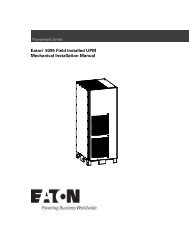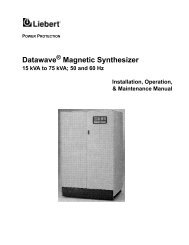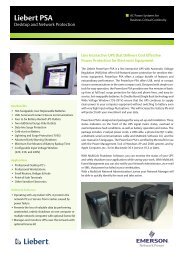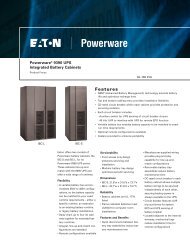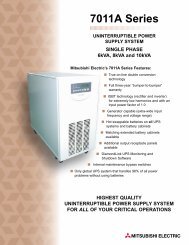Liebert Npower Sales Brochure.pdf - Gruber Power
Liebert Npower Sales Brochure.pdf - Gruber Power
Liebert Npower Sales Brochure.pdf - Gruber Power
Create successful ePaper yourself
Turn your PDF publications into a flip-book with our unique Google optimized e-Paper software.
AC <strong>Power</strong> Systems<br />
for Business-Critical Continuity<br />
<strong>Liebert</strong> <strong>Npower</strong> 30 to 130 kVA<br />
Innovative UPS Technology for Maximum <strong>Power</strong> Quality<br />
®<br />
<strong>Liebert</strong>
We’ve re-invented the<br />
double-conversion UPS<br />
Today’s business processes cannot be interrupted. Businesses are buying and selling around the world, around the clock, every day.<br />
Even 40-hours-per-week operations need the reliability and maintainability of true 24x7 infrastructure during those 40 hours.<br />
That’s why the cornerstone of your infrastructure should be the most reliable and advanced 3-phase UPS in its power range:<br />
the <strong>Liebert</strong> <strong>Npower</strong>.<br />
Frequency<br />
Variations<br />
Waveform<br />
Distortions<br />
Common-<br />
Mode<br />
Noise<br />
Input Faults<br />
Spikes<br />
Surges<br />
Sags<br />
100% Effectiveness<br />
Output Waveform, 0-100% Step Load<br />
Outages<br />
Output<br />
Current<br />
Output<br />
Voltage<br />
Reliability Comes First<br />
Reliability is a <strong>Liebert</strong> family tradition. All <strong>Liebert</strong><br />
three-phase UPS products use double-conversion<br />
technology and all have field-proven critical bus<br />
Mean Time Before Failure (MTBF) in excess of one<br />
million hours.<br />
Double Conversion for 100% Protection<br />
The UPS must support your business processes by<br />
providing clean, reliable uninterrupted power. A true<br />
double-conversion UPS is the only way to guard against<br />
the full spectrum of power disturbances. Anything less<br />
is a compromise.<br />
Single-conversion UPS products (off-line, line-interactive<br />
and some self-proclaimed "online" topologies) cannot<br />
provide complete protection. Common-mode noise<br />
and frequency variations will pass straight through to<br />
the critical load. In addition, single-conversion products<br />
are vulnerable to input faults.<br />
ActiveStar Controls for World-Class<br />
Performance<br />
The <strong>Liebert</strong> <strong>Npower</strong> has truly spectacular operating<br />
performance, unmatched by any UPS in the industry.<br />
The all-digital ActiveStar controls are DSP-based and<br />
feature unique, patent-pending technology. The<br />
<strong>Npower</strong> makes fast adjustments to changing loads,<br />
including subcycle pulse-width corrections to keep the<br />
output voltage waveform nearly flawless.<br />
Output voltage distortion (THD) typically measures<br />
less than 2.5%, under worst-case high-crest-factor,<br />
non-linear loads. The <strong>Npower</strong> is rugged enough to<br />
handle load branch faults, input faults, 100% step<br />
loads, PDU startup inrush and motor-load startup.<br />
2
Exceptional Overload<br />
Performance<br />
The combination of rugged inverter and continuous-rated<br />
static switch gives the <strong>Liebert</strong> <strong>Npower</strong> exceptional overload<br />
capability. By itself, the <strong>Npower</strong> inverter can supply up to<br />
200% of rated capacity for 10 cycles and 150% for a full minute<br />
while maintaining a true sinusoidal waveform to the load. It<br />
can also handle up to 125% of rated capacity for ten minutes.<br />
Even during bolted faults, the ActiveStar controls are able to<br />
limit inverter output current to safe levels.<br />
The internal static switch has two operating modes.<br />
For faults or transformer inrush currents, the static<br />
switch operates in the pulsed-parallel mode: the<br />
inverter remains connected while the static switch<br />
supplements inverter current with power from the<br />
bypass source. If the load continues to exceed the<br />
overload rating of the inverter, the static switch<br />
operates in the continuous-duty mode.<br />
When <strong>Npower</strong> is used in the 1+1 Redundant<br />
configuration, the full overload capacity of both<br />
modules is available to source fault current or handle<br />
momentary overloads. The inverters and static bypass<br />
switches work in parallel to support the critical load.<br />
Total power available will be limited by the rating and<br />
settings of the system output breaker in the Paralleling<br />
Cabinet. This breaker is typically set for the output<br />
rating of a single <strong>Npower</strong> module.<br />
%Load<br />
AMPS<br />
225<br />
200<br />
175<br />
150<br />
125<br />
100<br />
10000<br />
1000<br />
100<br />
Overload capability of <strong>Liebert</strong> <strong>Npower</strong><br />
UPS as a percent of nominal rating<br />
Inverter<br />
10 cycles 5 sec 1 min. 10 min. 100 min.<br />
6000<br />
3000<br />
1100<br />
1/2 cycle 10 cycles 1 sec 5 sec<br />
Time<br />
Static Switch<br />
Time<br />
Rating of the internal static switch in amps<br />
600<br />
The overload curves above tell a remarkable story. The upper curve<br />
represents inverter capability as a function of overload versus time.<br />
The inverter remains on-line providing regulated power output at<br />
full voltage at every point of the overload/time curve. The lower<br />
curve represents the capabilities of the internal static switch. If the<br />
load moves beyond the line representing inverter capacity, the<br />
static switch will support the load to the full extent of its capacity.<br />
The static switch has truly exceptional fault-clearing capacity, as<br />
shown in the second chart above. All <strong>Liebert</strong> <strong>Npower</strong> models have<br />
static switches rated for 6000 amps for the first half cycle, 3000<br />
amps for 10 cycles, 1100 amps for one second and 600 amps for<br />
5 seconds.<br />
110 % Load<br />
3
ActiveStar Controls for<br />
World-Class Performance<br />
ActiveStar is a DSP-based control system that makes the UPS behave like a model citizen. ActiveStar controls the entire power<br />
train, including the Rectifier, DC Bus, Inverter and Static Switch. This makes the <strong>Liebert</strong> <strong>Npower</strong> very aware of its environment,<br />
and able to make intelligent adjustments.<br />
Rectifier and DC Bus<br />
The rectifier has an unusually large<br />
window of usable input voltage.<br />
<strong>Liebert</strong> <strong>Npower</strong> is able to operate<br />
at full load without discharging the<br />
batteries even when input voltage<br />
drops 20% below nominal. The<br />
feed-forward frequency control of<br />
the rectifier allows it to track the<br />
output of an unstable generator.<br />
When the rectifier senses a large<br />
load step, it makes sub-cycle<br />
corrections to its phase angle and<br />
immediately begins drawing more<br />
power into the DC bus. This<br />
minimizes the effect of shortduration<br />
"hits" on the battery string<br />
and extends battery life.<br />
At lower load levels, ActiveStar<br />
disconnects the input filter<br />
capacitors, to keep from presenting<br />
a leading power factor to the utility<br />
or to the standby genset. As the<br />
load increases, ActiveStar reconnects<br />
the capacitors, to optimize the<br />
input power factor and minimize<br />
harmonic currents reflected back<br />
to the input source.<br />
<strong>Npower</strong> takes very good care<br />
of its batteries, with temperature<br />
compensated charging and other<br />
important features. As mentioned<br />
earlier, the rectifier responds<br />
quickly to load steps, reducing the<br />
number of short-duration battery<br />
Utility<br />
Input<br />
Input Inductor<br />
Trap<br />
Inductors<br />
"hits," which can greatly reduce<br />
battery life expectancy. In addition,<br />
the <strong>Npower</strong> can schedule regular<br />
battery self-test procedures, to<br />
verify that the battery string is<br />
capable of supporting the<br />
connected load.<br />
The internal battery cycle monitor<br />
records the duration, kW and battery<br />
end voltage for every battery<br />
discharge event. This enables you<br />
to evaluate battery performance<br />
Input Filter<br />
Disconnect<br />
<strong>Npower</strong><br />
Rectifier<br />
and see how hard your batteries<br />
are working in this application.<br />
The ActiveStar controls also<br />
optimize battery performance<br />
during longer discharge periods.<br />
During longer battery discharge<br />
events, the <strong>Npower</strong> gradually<br />
increases the low-battery shutdown<br />
voltage. This prevents the batteries<br />
from being discharged too deeply,<br />
and incrementally improves battery<br />
service life.<br />
4
ActiveStar Inverter Elements<br />
Voltage Error<br />
Desired Inverter<br />
Currents<br />
Current Error<br />
Desired Driving<br />
Voltage<br />
60Hz<br />
Voltage<br />
Reference<br />
Fast<br />
Automatic<br />
Harmonic<br />
Voltage Control<br />
(See detail below)<br />
Sliding Mode<br />
Inverter<br />
Current<br />
Control/Limit<br />
Space<br />
Vector<br />
PWM<br />
PWM<br />
Pulses<br />
Measured<br />
Output<br />
Voltage<br />
Measured<br />
Inverter<br />
Current<br />
60Hz<br />
Voltage<br />
Reference<br />
Inverter<br />
The ActiveStar inverter controls have three elements,<br />
Voltage Harmonic Control, Sliding Mode Inverter<br />
Current Control, and Space-Vector PWM Inverter.<br />
Voltage Harmonic Control compares the actual<br />
UPS output voltage to a 60Hz reference signal. It<br />
senses the content of load-generated harmonics and<br />
components introduced by unbalanced loads, and<br />
computes the compensating signals necessary to<br />
eliminate them. The Stabilizer then computes the<br />
amount of current necessary to force the voltage<br />
error to zero and ensure system stability.<br />
Details of Fast Automatic Harmonic Voltage Control<br />
Voltage<br />
Error<br />
Fundamental<br />
Frequency<br />
Desired<br />
Inverter<br />
Currents<br />
The Sliding-Mode Current Control takes the output<br />
from the Stabilizer and determines the driving voltage<br />
necessary to make inverter currents follow what the<br />
voltage control desires. The Current Control corrects<br />
errors between desired and actual current in a single<br />
PWM pulse. On a bolted fault, this allows the inverter<br />
to limit its current at a safe level, rather than requiring<br />
immediate shutdown when bypass is not available.<br />
ActiveStar compensates once per PWM pulse (50 times<br />
per line cycle) compared to older UPS technology,<br />
which limits currents by gradually reducing its 60 Hz<br />
voltage reference once per line cycle (1/60 sec.).<br />
ActiveStar constantly monitors the harmonics being<br />
reflected by the customer’s load equipment, and<br />
cancels them electronically. The inverter sources<br />
(compensates for) the harmonics as it sends pulses<br />
through the output isolation transformer. As a result,<br />
the output transformer never directly experiences the<br />
harmonics, and runs cooler and quieter.<br />
Measured<br />
Output<br />
Voltage<br />
3rd<br />
Harmonic<br />
5th<br />
Harmonic<br />
S T ABI LIZER<br />
7th<br />
Harmonic<br />
etc<br />
Measured System<br />
Output Currents<br />
5
<strong>Liebert</strong> <strong>Npower</strong>: The Best<br />
Value in a Mid-Range UPS<br />
The <strong>Liebert</strong> <strong>Npower</strong> gives you more UPS for about the same<br />
initial cost as lesser products. Furthermore, the <strong>Npower</strong> will<br />
usually cost significantly less over the lifetime of the product.<br />
The value comes from several elements: exceptional<br />
protection, higher efficiency, lower installation, maintenance<br />
and operating costs, smaller total system footprint and more<br />
standard features.<br />
Higher Efficiency in Real-World Applications<br />
Critical applications require a UPS to have an input<br />
filter (to reduce input current distortion) and an output<br />
isolation transformer (to isolate your critical load),<br />
while powering non-linear (high-crest-factor) loads<br />
at less than the rated capacity of the UPS.<br />
The fully equipped <strong>Liebert</strong> <strong>Npower</strong> has excellent<br />
efficiency – typically between 92% and 93.5% – while<br />
powering high-crest-factor loads between 50 and 100%<br />
of its rated capacity. Furthermore, the input power<br />
factor is exceptionally high, typically 0.95 to 0.96 for<br />
models with 480 VAC input.<br />
In this power range (up to 130 kVA), the only way<br />
to exceed 93.5% efficiency is to leave out something<br />
important. Some competitors omit the output isolation<br />
transformer; others put your critical load at risk with<br />
their single-conversion UPS products. Only you can<br />
decide if the claimed savings justify the risk.<br />
High-Availability Configurations<br />
The <strong>Liebert</strong> <strong>Npower</strong> UPS can be used reliably as a<br />
single module and in various redundant configurations.<br />
The <strong>Npower</strong> 1+1 Redundant option, described on pages<br />
10-11 of this brochure, is a cost-effective parallelredundant<br />
system. Parallel redundancy improves<br />
maintainability and fault tolerance, thereby enhancing<br />
system availability.<br />
For the ultimate in high-availability systems, <strong>Npower</strong><br />
can be applied in various distributed-redundant<br />
(dual-bus) configurations, using <strong>Liebert</strong>’s unique Load<br />
Bus Sync option. Both Load Bus Sync and 1+1<br />
Redundant configurations can be factory-installed or<br />
retrofitted to existing <strong>Npower</strong> installations.<br />
6
Easy to Purchase and Install<br />
The <strong>Liebert</strong> <strong>Npower</strong> can be as simple or complete as you need<br />
it to be. With matching battery cabinets, maintenance bypass<br />
cabinets, Slim-Line power distribution cabinets and Paralleling<br />
Cabinets, the <strong>Npower</strong> can be a bolt-together system.<br />
All bolt-on cabinets have casters and leveling feet,<br />
to simplify installation. Furthermore, power cables<br />
and control wiring harnesses between cabinets are<br />
included for all cabinets (except Paralleling Cabinets),<br />
saving time and cost.<br />
System Footprint (Sq. Ft.)<br />
Smallest Complete-System Footprint<br />
The <strong>Liebert</strong> <strong>Npower</strong> achieves a small footprint despite<br />
being a full-featured, double-conversion UPS.<br />
Furthermore, <strong>Liebert</strong> understands that real systems<br />
have battery cabinets, maintenance bypass cabinets<br />
and some type of power distribution cabinets.<br />
Therefore, our design goal was to build complete<br />
systems, in all their variant forms, in the smallest<br />
practical size consistent with good engineering<br />
practices. Consider this:<br />
■ No size penalty for 208 VAC input or output. For each<br />
kVA rating, all input voltages and all output voltages<br />
fit in the same size package.<br />
■ Input isolation and bypass isolation transformers fit<br />
inside the same package.<br />
■ Battery trays slide out the front for maintenance.<br />
■ Bypass isolation transformers can also be built into<br />
your maintenance bypass cabinet.<br />
■ The Slim Line distribution unit adds just 10 inches<br />
to the width of the UPS module, but gives you 42<br />
or 84 poles.<br />
35<br />
30<br />
25<br />
20<br />
15<br />
10<br />
5<br />
0<br />
130 kVA<br />
80 kVA<br />
<strong>Liebert</strong><br />
<strong>Npower</strong><br />
50 kVA<br />
130 kVA<br />
80 kVA<br />
System Footprint<br />
UPS+Battery+Output Isolation<br />
50 kVA<br />
130 kVA<br />
80 kVA<br />
50 kVA<br />
130 kVA<br />
80 kVA<br />
Brand M Brand P Brand A<br />
50 kVA<br />
7
<strong>Liebert</strong> <strong>Npower</strong>: Configurations<br />
for Any Application<br />
Input and Output Configurations<br />
Single or Dual Input:<br />
■ Single-input UPS products are often favored in this<br />
power range (30 to 130 kVA). This is the simplest and<br />
lowest-cost solution. It features a single input bus,<br />
with both the input and bypass circuits fed from the<br />
same external feeder breaker.<br />
■ Dual-input UPS products have<br />
separate busses for the rectifier input and the bypass<br />
circuit. This adds a measure of fault tolerance,<br />
because a single external breaker failure will not<br />
cause the load to fail. It also adds cost: an additional<br />
input feeder breaker and more input cabling.<br />
Isolated or Non-Isolated Neutral<br />
Proper grounding is essential for reliable UPS<br />
operation. The installing contractor must ensure the<br />
integrity of the ground and neutral connections and<br />
select the UPS best suited for the facility.<br />
The <strong>Liebert</strong> <strong>Npower</strong> can be ordered with or without<br />
an isolated bypass neutral. With an isolated neutral, the<br />
UPS contains an internal bypass isolation transformer<br />
and does not require an input neutral brought in from<br />
the service entrance. Shown below are the various<br />
configurations and their applications:<br />
■ A non-isolated neutral is the lowest-cost option, but<br />
requires the installing contractor to pull a neutral line<br />
from service entrance. This configuration can support<br />
three-wire or four-wire-plus-ground loads where the<br />
input and output voltages are the same.<br />
■ An isolated neutral with Delta-Wye isolation<br />
transformer is able to support 3-wire or 4-wire-plusground<br />
loads of any sort.The output is phase-shifted<br />
30 degrees from the input.<br />
■ An isolated neutral with Wye-Wye isolation<br />
transformer is able to support 3-wire loads at the<br />
supply voltage. The output is in phase with the input.<br />
This configuration cannot support 4-wire loads.<br />
One-Line Diagram<br />
Single-Input with delta-wye output<br />
Continuous<br />
Rated Static<br />
Switch<br />
Y<br />
UPS<br />
Input<br />
Rectifier<br />
Inverter<br />
Critical<br />
Load<br />
Battery<br />
Cabinet<br />
8
Specific Configurations<br />
Configuration A & B With Non-Isolated Bypass<br />
Input<br />
Static<br />
Switch<br />
Module<br />
Load<br />
This configuration is for applications where the input is 4-wire plus<br />
ground. Output voltage must be the same as the input voltage.<br />
This configuration cannot have the neutral-to-ground bond at the<br />
UPS module. The output is 4-wire plus ground. The output is in<br />
phase with the input.<br />
Single Input Configurations<br />
Input<br />
Static<br />
Switch<br />
Module<br />
Y<br />
Load<br />
Configuration D & E With Load Neutral Isolation<br />
This configuration is for applications where the UPS provides<br />
isolation on both the inverter and the bypass circuit. This configuration<br />
has the neutral-to-ground bond at the UPS module. The input is<br />
3-wire plus ground, and the output is 4-wire plus ground. The<br />
output is 30° phase-shifted from the input.<br />
Input<br />
Static<br />
Switch<br />
Module<br />
Y<br />
Y<br />
Load<br />
Configurations R & S With Load Neutral Isolation<br />
This configuration is for applications with 480 VAC input and 480<br />
VAC output, and there are no line-to-neutral loads. The UPS provides<br />
isolation on both the inverter and the bypass circuit. This configuration<br />
has the neutral-to-ground bond at the UPS module. The input and<br />
output are both 3-wire plus ground. The output is in phase with<br />
the input.<br />
Configuration A & B:With Non-Isolated Bypass<br />
Bypass<br />
Input<br />
Static<br />
Switch<br />
Module<br />
Load<br />
This configuration is for applications where the bypass input is<br />
4-wire plus ground. Output voltage must be the same as the bypass<br />
input voltage. The rectifier input is 3-wire plus ground. The output is<br />
4-wire plus ground. The output is in phase with the bypass input.<br />
Dual Input Configurations<br />
Bypass<br />
Input<br />
Bypass<br />
Input<br />
Static<br />
Switch<br />
Module<br />
Static<br />
Switch<br />
Module<br />
Y<br />
Y<br />
Y<br />
Load<br />
Load<br />
Configurations D & E: With Load Neutral Isolation<br />
This configuration is for applications where the UPS provides<br />
isolation on both the inverter and the bypass circuit. This configuration<br />
has the neutral-to-ground bond at the UPS module. The rectifier and<br />
bypass inputs are 3-wire plus ground, and the output is 4-wire plus<br />
ground. The output is 30° phase-shifted from the bypass input.<br />
Configurations R & S: With Load Neutral Isolation<br />
This configuration is for applications with 480 VAC bypass input<br />
and 480 VAC output and there are no line-to-neutral loads. The UPS<br />
provides isolation on both the inverter and the bypass circuit. This<br />
configuration has the neutral-to-ground bond at the UPS module.<br />
The rectifier and bypass inputs and the output are all 3-wire plus<br />
ground. The output is in phase with the bypass input.<br />
9
<strong>Npower</strong> 1+1 Redundant:<br />
A Simpler Way to Improve Availability<br />
The <strong>Liebert</strong> <strong>Npower</strong> 1+1 Redundant system is an elegantly simple way to create a parallel-redundant UPS without the cost or<br />
complexity of external system controls. Adding a redundant UPS module to a single-module system improves maintainability,<br />
because the second module can support the load while the first is being serviced. A redundant module also improves fault<br />
tolerance, because a single failure will still leave an intact UPS to support the critical load.<br />
<strong>Liebert</strong> has nearly 30 years of experience building<br />
multi-module UPS systems, but the majority of these<br />
systems have system-level controls. These controls are<br />
necessary for large-scale power systems, but are less<br />
important for smaller systems. The <strong>Liebert</strong> <strong>Npower</strong><br />
1+1 Redundant system strikes a good balance<br />
between the simplicity of a single module and the<br />
performance of a multi-module system.<br />
No System-Level Controls<br />
All control logic is contained within the individual<br />
modules. Unlike conventional multi-module systems,<br />
there is no system-level LCD panel or static bypass<br />
switch. The module-level static bypass switches<br />
work in coordination to provide exceptional overload<br />
protection, plus seamless transfers between bypass<br />
and online operating modes.<br />
Furthermore, the traditional system control cabinet<br />
is replaced by a simple paralleling cabinet. Normal<br />
operations can be handled efficiently at the individual<br />
module control panels.<br />
Bypass<br />
Input<br />
Static<br />
Switch<br />
Module<br />
UPS1<br />
Load<br />
Static<br />
Switch<br />
Paralleling<br />
Cabinet<br />
Module<br />
UPS2<br />
10
Paralleling Cabinets: Better Solutions<br />
<strong>Liebert</strong> <strong>Npower</strong> 1+1 Paralleling Cabinets feature<br />
three circuit breakers: two module disconnect breakers<br />
and a system output breaker. The third breaker meets<br />
NEC requirements for a system output breaker. Some<br />
competitor products only have the two module<br />
disconnect breakers. This forces the installing contractor<br />
to size, purchase, coordinate, install and run conduit<br />
to an external output breaker.<br />
Our standard wall-mounted panelboards give great<br />
flexibility in component placement. Consult your<br />
<strong>Liebert</strong> sales representative for optional cabinet<br />
configurations.<br />
Better than Wireless<br />
Both UPS modules in a <strong>Liebert</strong> <strong>Npower</strong> 1+1 system<br />
are completely independent. They function as true<br />
peers, rather than as master or slave.<br />
A single Category 5 Ethernet cable connects the<br />
modules. The cable enables the modules to “learn” and<br />
calibrate themselves during initial system start-up. After<br />
start-up, the cable optimizes system communications<br />
and performance in several areas. It enables the<br />
modules to load share with a precision of +/- 1%. It also<br />
enables the modules to load share during battery<br />
discharge, improving battery runtimes by 15-30%.<br />
Although it enhances system performance, the cable<br />
is not required for system operation. Should the cable<br />
become severed or disconnected, the <strong>Npower</strong> modules<br />
will continue to share load within +/- 5% (typically<br />
within +/- 3%). The system will continue to provide<br />
conditioned power to the critical load without<br />
interruption. Likewise, the modules will still be capable<br />
of automatic fault isolation, and the operator can<br />
still perform manual transfers to and from bypass.<br />
In summary, <strong>Liebert</strong> system designers chose the<br />
performance advantages of a wired paralleling<br />
system, but the wires were not permitted to become<br />
a failure mode.<br />
New or Retrofit<br />
All configurations of <strong>Liebert</strong> <strong>Npower</strong> modules can<br />
be used in 1+1 Redundant systems. New systems can<br />
be ordered with all the components included. Installed<br />
systems can be retrofitted with a simple kit.<br />
11
<strong>Liebert</strong> Monitoring Solutions:<br />
When You Need To Know<br />
<strong>Liebert</strong> has built advanced monitoring and communications capabilities<br />
into the <strong>Liebert</strong> <strong>Npower</strong> UPS system. <strong>Liebert</strong> monitoring and control<br />
products allow you to take full advantage of these features. You will find a<br />
full range of monitoring and control systems, communications modules and<br />
other equipment designed to interface with a variety of communication<br />
protocols, operating platforms and building management systems.<br />
Knowing what is happening with your power equipment, so you<br />
can keep it at peak operating efficiency, is vital to system reliability.<br />
Network-Based<br />
Monitoring<br />
Systems<br />
Important facility operational and status information needs to be<br />
communicated by different means with varying levels of importance.<br />
This is why <strong>Liebert</strong> gives you so many ways to supervise your enterprise:<br />
IT Manager<br />
Network<br />
Data Center<br />
Facility<br />
Enterprise<br />
Single Phase<br />
Uninterruptible<br />
<strong>Power</strong> System<br />
Three Phase<br />
Uninterruptible<br />
<strong>Power</strong> System<br />
MultiLink<br />
OpenComms Nform<br />
OpenComms Nform<br />
OpenComms Nform<br />
SiteScan Web<br />
<strong>Power</strong><br />
Management<br />
Environmental<br />
Control<br />
OpenComms Nform<br />
SiteScan Web<br />
<strong>Liebert</strong> SiteScan Web<br />
Enterprise Monitoring Systems<br />
<strong>Liebert</strong> SiteScan Web is a<br />
comprehensive critical systems<br />
monitoring solution dedicated to<br />
ensuring reliability through graphics,<br />
event management and data<br />
extrapolation. The standard Web<br />
interface allows users easy<br />
access from “anywhere” at “anytime.”<br />
■ Single and multi-site applications.<br />
■ Event management and unit control.<br />
■ Trend and historical data captures<br />
and reporting.<br />
■ Full ASHRAE BACnet compatibility.<br />
■ Java based.<br />
■ Windows 2000 and XP compatible.<br />
Network-Based Monitoring Systems<br />
The OpenComms Nform family of<br />
monitoring software and communications<br />
hardware solutions combines the<br />
coverage of facility monitoring with the<br />
efficiency of a network-based system.<br />
They provide a cost-effective, centralized<br />
monitoring solution flexible enough<br />
to support your critical system<br />
configurations while utilizing your<br />
existing distributed infrastructure.<br />
Stand-Alone<br />
Monitoring Solutions<br />
UPS shutdown software, as well as<br />
autonomous microprocessor controlled<br />
modules, are available to provide<br />
supervision, control and remote alarm<br />
notification for <strong>Liebert</strong> power equipment.<br />
MultiLink Automated<br />
Shutdown Software<br />
MultiLink will monitor UPS status<br />
and perform user-specified actions<br />
to execute notifications and provide<br />
automated, unattended system<br />
shutdown to protect critical data<br />
during extended power outages.<br />
Universal Monitor<br />
All-purpose microprocessor-based<br />
alarm and notification unit that<br />
allows a variety of <strong>Liebert</strong> equipment<br />
to be monitored and controlled<br />
both remotely and locally from a<br />
single point.<br />
12
Monitoring And Service Solutions<br />
From <strong>Liebert</strong> Global Services<br />
SiteScan Web Enterprise<br />
Monitoring Systems<br />
Stand-Alone<br />
Monitoring<br />
Solutions<br />
Remote Monitoring Service:<br />
When You Need To Know - But<br />
Can’t Do It Yourself<br />
The key to providing proper<br />
service for critical support systems<br />
is being aware of that equipment’s<br />
operating status at any given time.<br />
That’s why <strong>Liebert</strong> is so firmly<br />
committed to providing monitoring<br />
capability in our power products.<br />
Our Remote Monitoring Service is<br />
designed to maximize the capabilities<br />
of your <strong>Liebert</strong> equipment by<br />
maximizing the effectiveness of<br />
your monitoring systems.<br />
Always There, Always Alert<br />
Combining the capabilities of your<br />
<strong>Liebert</strong> monitoring systems with<br />
<strong>Liebert</strong> Global Services’ (LGS)<br />
Remote Monitoring Service provides<br />
you with a seamless rapid-response<br />
system. <strong>Liebert</strong> can monitor your<br />
facility around-the-clock from the<br />
LGS Customer Response Center (CRC).<br />
When a problem is detected, the<br />
monitoring system immediately<br />
alerts the CRC where each alarm is<br />
evaluated and processed. The alarm<br />
processor offers instant phone<br />
assistance using a customer-defined<br />
response and call escalation plan.<br />
<strong>Liebert</strong> will coordinate all service<br />
vendors, track the response and<br />
solution time for service calls and<br />
provide comprehensive reports on<br />
alarms and corrective actions.<br />
No matter where your facilities are<br />
located, LGS Remote Monitoring can<br />
provide continuous oversight of a<br />
wide range of critical installations.<br />
From simple, single-unit unmanned<br />
electrical shelters to complex<br />
campus-based data centers, LGS<br />
Remote Monitoring Service can<br />
help you keep watch over critical<br />
protection equipment.<br />
LGS Service Excellence<br />
Our Service Excellence programs<br />
provide a simple and easy to<br />
understand strategy for meeting all<br />
of your company’s service needs.<br />
Basic, Essential, and Preferred<br />
service levels allow you to select<br />
the complement of critical power<br />
services that best fits your<br />
requirements. These programs<br />
include guaranteed four-hour<br />
response time, emergency service<br />
and preventive maintenance.<br />
<strong>Liebert</strong> Global Services provides<br />
unequalled coverage and support<br />
with over 300 factory-trained<br />
customer engineers located<br />
coast-to-coast. With access to<br />
thousands of parts in the field, and<br />
hundreds of factory parts depots,<br />
our customer engineers have direct<br />
access to the most comprehensive<br />
authorized parts network in the<br />
industry. This results in immediate<br />
parts availability, or within 24 hours,<br />
guaranteed.<br />
Training And Support Make<br />
The Difference<br />
Our factory-trained customer<br />
engineers receive in-depth<br />
instruction and hands-on<br />
experience in servicing the most<br />
current <strong>Liebert</strong> products. We also<br />
provide them with immediate<br />
online access to detailed schematics<br />
and your equipment’s complete<br />
service record from the time it was<br />
started up. With access to our<br />
national technical support<br />
resources, LGS customer engineers<br />
bring the best training, the best<br />
technology and the best network<br />
of technical professionals to your<br />
critical space.<br />
13
General Specifications<br />
Specifications<br />
UPS Rating Battery Maximum Heat Dimensions (WxDxH) 2 Approximate Weight 3<br />
Nominal<br />
Dissipation At<br />
kVA kW (VDC) Full Load (BTU/Hr) 1 Inches MM Pounds KG<br />
30 24 480 8,500 31.7x32.5x71 805x825x1800 2,200 1,000<br />
40 32 480 11,000 31.7x32.5x71 805x825x1800 2,200 1,000<br />
50 40 480 14,000 31.7x32.5x71 805x825x1800 2,200 1,000<br />
65 52 480 18,000 39.4x32.5x71 1000x825x1800 2,700 1,225<br />
80 64 480 22,000 39.4x32.5x71 1000x825x1800 2,700 1,225<br />
100 80 480 26,000 49.2x32.5x71 1250x825x1800 3,800 1,725<br />
130 104 480 33,000 49.2x32.5x71 1250x825x1800 3,800 1,725<br />
1<br />
Heat dissipation figures are for worst-case configurations (including 208 VAC, input and output), supporting 100% load at rated power factor.<br />
2<br />
Dimensions and weights do not include battery or maintenance bypass cabinets.<br />
3<br />
Weights are for heaviest models, with 208 VAC input.<br />
<strong>Liebert</strong> <strong>Npower</strong> Matching Battery Cabinet<br />
Run Time (minutes) Dimensions (WxDxH) Weight<br />
Model 30 kVA 40kVA 50kVA 65kVA 80kVA 100kVA 130kVA inches mm lbs kg<br />
1FJ 12 7 - - - - - 25x32.5x71 635x825x1800 1,600 725<br />
1HJ 21 14 10 7 5 - - 25x32.5x71 635x825x1800 1,800 815<br />
1LJ 28 20 14 8 5 - - 25x32.5x71 635x825x1800 2,350 1,065<br />
1MJ 36 25 18 12 8 5 - 25x32.5x71 635x825x1800 2,350 1,065<br />
1PJ 53 38 28 20 15 10 - 25x32.5x71 635x825x1800 3,000 1,360<br />
1PJ (130) - - - - - - 7 49x32.5x71 1250x825x1800 3,350 1,520<br />
1RJ 62 45 34 25 19 13 9 49x32.5x71 1250x825x1800 3,700 1,680<br />
1UJ 72 52 39 30 23 17 12 49x32.5x71 1250x825x1800 4,000 1,815<br />
1WJ 104 74 55 40 33 25 16 49x32.5x71 1250x825x1800 5,050 2,290<br />
2PJ 126 83 67 50 38 28 - (2) 25x32.5x71 (2) 635x825x1800 6,000 2,720<br />
2PJ (130) - - - - - - 20 (2) 49x32.5x71 (2) 1250x825x1800 6,700 3,040<br />
2RJ 144 104 76 55 45 35 25 (2) 49x32.5x71 (2) 1250x825x1800 7,400 3,360<br />
2UJ 156 111 90 67 52 40 30 (2) 49x32.5x71 (2) 1250x825x1800 8,000 3,630<br />
2WJ - - - 97 74 55 40 (2) 49x32.5x71 (2) 1000x825x1800 10,100 4,580<br />
3PJ 204 145 108 78 63 48 - (3) 25x32.5x71 (3) 635x825x1800 9,000 4,080<br />
3PJ (130) - - - - - - 35 (3) 49x32.5x71 (3) 1250x825x1800 10,050 4,560<br />
3RJ 223 161 129 94 72 54 39 (3) 49x32.5x71 (3) 1250x825x1800 11,100 5,340<br />
3UJ 265 187 142 105 81 65 48 (3) 49x32.5x71 (3) 1250x825x1800 12,000 5,445<br />
3WJ 421 302 217 157 154 94 69 (3) 49x32.5x71 (3) 1250x825x1800 15,150 6,870<br />
4PJ 301 206 154 111 90 68 - (4) 25x32.5x71 (4) 635x825x1800 12,000 5,440<br />
4PJ (130) - - - - - - 50 (4) 49x32.5x71 (4) 1250x825x1800 13,400 6,080<br />
4RJ 329 224 182 134 102 77 55 (4) 49x32.5x71 (4) 1250x825x1800 14,800 6,720<br />
4UJ 377 266 201 147 111 91 67 (4) 49x32.5x71 (4) 1250x825x1800 16,000 7,260<br />
4WJ 480 423 320 222 180 135 97 (4) 49x32.5x71 (4) 1250x825x1800 20,200 9,160<br />
14
Input<br />
Voltage: 208, 220, 240, 480 or 600 VAC, 60 Hz. 3-phase,<br />
3-or 4-wire plus ground<br />
Voltage Range: +10, -15% (no battery discharge at -20%)<br />
Frequency Range: 60 Hz, ± 5 Hz<br />
Current Distortion: 10% maximum reflected THD at full<br />
load with optional input filter. 30% THD without filter.<br />
Current Limit: 115% of full load input current<br />
Current Walk-in: 20 seconds to full load.<br />
<strong>Power</strong> Factor: Up to 0.96 lagging at full load with<br />
optional input filter. 0.80 lagging minimum at full load<br />
without optional input filter.<br />
Surge Protection: Sustains input surges without damage,<br />
per criteria listed in ANSI C62.41-1980, A & B (IEEE 587).<br />
Output<br />
Voltage: 208, 220, 240, 480 or 600 VAC, 60 Hz, 3-phase,<br />
4-wire plus ground.<br />
Voltage Adjustment Range: ±5%.<br />
Voltage Regulation:<br />
±0.5% for balanced load<br />
±1.0% for 100% unbalanced load.<br />
Dynamic Regulation: ± 2.5% deviation for 100% load<br />
step. ±1% for loss or return of AC input.<br />
Transient Response Time: Recover to steady state<br />
within 1 cycle.<br />
Voltage Distortion: For linear loads, 1% THD. Less than<br />
2.5% THD for 100% nonlinear loads (3:1 crest factor)<br />
without kVA/kW derating.<br />
Phasing Balance: 120° ±0.5° for balanced load. 120° ±1°<br />
for 100% unbalanced load. Frequency Regulation: ±0.1%.<br />
Load <strong>Power</strong> Factor Range: 1.0 to 0.7 lagging<br />
without derating.<br />
Overload: 125% of full load for ten minutes. 150% for<br />
one minute with true sinusoidal waveform.<br />
Environmental<br />
Operating Temperature: 0° to 40°C (UPS), 20°<br />
to 30°C (battery)<br />
Non-Operating Temperature: -20°C to 70°C.<br />
Relative Humidity: 0-95% non-condensing<br />
Operating Altitude: Up to 6,600 feet (2000 meters)<br />
without derating.<br />
Acoustical Noise: Less than 65 dBA typical, measured<br />
1 meter from the unit.<br />
Standards<br />
ETL Listed to UL 1778 and UL 924 UPS standards,<br />
and CSA certified. Meets current requirements for<br />
safe high-performance UPS operation.<br />
Standard Features<br />
Like other <strong>Liebert</strong> UPS products,<br />
the <strong>Liebert</strong> <strong>Npower</strong> includes some<br />
features that are options (or not<br />
available) for some competitors:<br />
■ True double-conversion topology,<br />
for protection against 100% of<br />
power \disturbances.<br />
■ Internal bypass switch enables<br />
you to isolate the UPS for<br />
maintenance.<br />
■ Continuous-duty static switch<br />
performs in pulsed-parallel mode<br />
for supplying fault current and<br />
momentary overloads, and can<br />
operate continuously for longerduration<br />
events.<br />
■ Internal output isolation<br />
transformer protects your critical<br />
load from \common-mode noise<br />
and harmful DC offsets. In some<br />
configurations, it \provides a<br />
separately derived source,<br />
to support 4-wire loads without<br />
having to pull a neutral line from<br />
the \service entrance.<br />
■ Automatic input filter disconnect<br />
isolates the input filter capacitors<br />
at light loads to avoid presenting a<br />
leading power factor to the utility<br />
or backup generator.<br />
■ Backlit LCD graphic display<br />
enables easy navigation between<br />
the graphic mimic screen and the<br />
menu screens.<br />
■ Event Log can display up to<br />
512 time-and-date-stamped<br />
alarm events.<br />
■ Battery self-test helps verify the<br />
battery’s readiness to carry the<br />
critical load.<br />
■ Battery temperature-compensated<br />
charging prevents overcharging<br />
in high ambient operating<br />
temperature or undercharging<br />
in cold weather.<br />
■ Battery Cycle Monitor records up<br />
to 132 battery discharge events.<br />
■ Battery Time Remaining feature<br />
displays backup time remaining<br />
at present connected load.<br />
■ On-generator battery charge limit<br />
reduces recharge current until the<br />
utility AC power is restored.<br />
■ Front-panel control of all<br />
configuration and fieldadjustment<br />
options simplify<br />
installation and maintenance.<br />
■ Top-and-bottom cable entry<br />
gives the installer more options<br />
for equipment location.<br />
■ Two-hole bus bar landing space<br />
and accessible terminal blocks for<br />
options can simplify installation.<br />
■ Casters under the unit are<br />
helpful when a forklift is not<br />
readily available.<br />
■ One-button startup for<br />
simpler operation.<br />
Options and Accessories<br />
■ Matching valve-regulated<br />
lead-acid battery packs<br />
■ Matching maintenance<br />
bypass cabinet<br />
■ Matching bolt-on power<br />
distribution unit, with one<br />
or two 42-pole panels<br />
■ Input filter/power<br />
factor correction<br />
■ Internally mounted input<br />
isolation transformer<br />
■ Load Bus Sync Systems<br />
■ 1+1 Redundant Systems<br />
■ Flooded rack-mounted<br />
battery systems<br />
■ SNMP, SiteScan and other<br />
communications interfaces:<br />
■ Remote monitor panel<br />
■ Alarm status contacts<br />
■ Customer alarm inputs<br />
15
Ensuring The High Availability Of<br />
Mission-Critical Data And Applications.<br />
Emerson Network <strong>Power</strong>, the global leader in enabling business-critical<br />
continuity, ensures network resiliency and adaptability through a family<br />
of technologies — including <strong>Liebert</strong> power and cooling technologies —<br />
that protect and support business-critical systems. <strong>Liebert</strong> solutions employ<br />
an adaptive architecture that responds to changes in criticality, density and<br />
capacity. Enterprises benefit from greater IT system availability, operational<br />
flexibility, and reduced capital equipment and operating costs.<br />
<strong>Liebert</strong> Corporation<br />
1050 Dearborn Drive<br />
P.O. Box 29186<br />
Columbus, Ohio 43229<br />
800 877 9222 Phone (U.S. &<br />
Canada Only)<br />
614 888 0246 Phone (Outside U.S.)<br />
614 841 6022 FAX<br />
Via Leonardo Da Vinci 8<br />
Zona Industriale Tognana<br />
35028 Piove Di Sacco (PD)<br />
Italy<br />
39 049 9719 111 Phone<br />
39 049 5841 257 FAX<br />
Emerson Network <strong>Power</strong> Asia Pacific<br />
7/F., Dah Sing Financial Centre<br />
108 Gloucester Rd, Wanchai<br />
Hong Kong<br />
852 25722201 Phone<br />
852 28029250 FAX<br />
liebert.com<br />
24 x 7 Tech Support<br />
800 222 5877 Phone<br />
614 841 6755 (outside U.S.)<br />
While every precaution has been taken to ensure accuracy and<br />
completeness in this literature, <strong>Liebert</strong> Corporation assumes no<br />
responsibility, and disclaims all liability for damages resulting<br />
from use of this information or for any errors or omissions.<br />
© 2005 <strong>Liebert</strong> Corporation. All rights reserved throughout<br />
the world. Specifications subject to change without notice.<br />
All names referred to are trademarks or registered trademarks<br />
of their respective owners.<br />
® <strong>Liebert</strong> and the <strong>Liebert</strong> logo are registered trademarks<br />
of the <strong>Liebert</strong> Corporation.<br />
SL-24529 (R8/05)<br />
Printed in USA<br />
Emerson Network <strong>Power</strong>.<br />
The global leader in enabling business-critical continuity.<br />
AC <strong>Power</strong> Systems<br />
Connectivity<br />
DC <strong>Power</strong> Systems<br />
Embedded <strong>Power</strong><br />
Inbound <strong>Power</strong><br />
Integrated Cabinet Solutions<br />
Outside Plant<br />
Precision Cooling<br />
Site Monitoring and Services<br />
EmersonNetwork<strong>Power</strong>.com<br />
Emerson Network <strong>Power</strong> and the Emerson Network <strong>Power</strong> logo are trademarks and service marks of Emerson Electric Co. ©2005 Emerson Electric Co.



